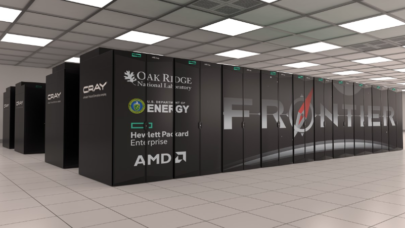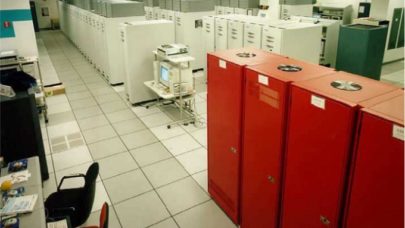
China’s Quiet Journey into Exascale Computing
September 17, 2023
As reported in the South China Morning Post HPC pioneer Jack Dongarra mentioned the lack of benchmarks from recent HPC systems built by China. “It’s a we Read more…
Cerebras Has Big Plans for Big AI Chips: Build Your Own Cloud
July 20, 2023
Hyping an AI chip is one thing, but proving its usability in the commercial market is a bigger challenge. Some AI chip companies -- which are still prov Read more…

Thomas Sterling’s ISC Keynote Celebrates Frontier and the Exascale Tour de Force
June 1, 2022
For a change, said Thomas Sterling, long-time ISC keynoter and HPC pioneer, picking a theme for his 2022 talk wasn’t a challenge. “What is the word you need that everyone will remember and agree to about a particular year? This was easy. It's exaflops. I mean real exaflops, you know, the kind you can get your teeth into exaflops, not words like exascale or low-precision exaflops, or 'we know what an exaflops is, right... Read more…

Reflecting on the 25th Anniversary of ASCI Red and Continuing Themes for Our Heterogenous Future
April 26, 2022
In the third of a series of guest posts on heterogeneous computing, James Reinders shares experiences surrounding the creation of ASCI Red and ties that system' Read more…

New National HPC Strategy Is Bold, Important and More Daunting than US Moonshot
August 6, 2015
“In order to maximize the benefits of HPC for economic competitiveness and scientific discovery, the United States Government must create a coordinated Federa Read more…

Manufacturing Exascale
July 7, 2014
Exascale systems are certainly the current buzz in high performance computing. While theoretical projections suggest the possibility to have an exascale system Read more…

DOE Sets Exascale Pricetag
September 16, 2013
The United States Department of Energy has announced a plan to field an exascale system by 2022, but says in order to meet this objective it will require an investment of $1 billion to $1.4 billion for targeted research and development. Read more…

Future Challenges of Large-Scale Computing
April 15, 2013
Ahead of his opening conference keynote at ISC'13, Bill Dally, chief scientist at NVIDIA and senior vice president of NVIDIA Research, shares his views on where HPC is headed. Among the key topics covered are the demand for heterogenous computing, overcoming the memory wall, the implications of government belt-tightening, and much more... Read more…

- Click Here for More Headlines

Whitepaper
Transforming Industrial and Automotive Manufacturing
In this era, expansion in digital infrastructure capacity is inevitable. Parallel to this, climate change consciousness is also rising, making sustainability a mandatory part of the organization’s functioning. As computing workloads such as AI and HPC continue to surge, so does the energy consumption, posing environmental woes. IT departments within organizations have a crucial role in combating this challenge. They can significantly drive sustainable practices by influencing newer technologies and process adoption that aid in mitigating the effects of climate change.
While buying more sustainable IT solutions is an option, partnering with IT solutions providers, such and Lenovo and Intel, who are committed to sustainability and aiding customers in executing sustainability strategies is likely to be more impactful.
Learn how Lenovo and Intel, through their partnership, are strongly positioned to address this need with their innovations driving energy efficiency and environmental stewardship.
Download Now
Sponsored by Lenovo
Whitepaper
How Direct Liquid Cooling Improves Data Center Energy Efficiency
Data centers are experiencing increasing power consumption, space constraints and cooling demands due to the unprecedented computing power required by today’s chips and servers. HVAC cooling systems consume approximately 40% of a data center’s electricity. These systems traditionally use air conditioning, air handling and fans to cool the data center facility and IT equipment, ultimately resulting in high energy consumption and high carbon emissions. Data centers are moving to direct liquid cooled (DLC) systems to improve cooling efficiency thus lowering their PUE, operating expenses (OPEX) and carbon footprint.
This paper describes how CoolIT Systems (CoolIT) meets the need for improved energy efficiency in data centers and includes case studies that show how CoolIT’s DLC solutions improve energy efficiency, increase rack density, lower OPEX, and enable sustainability programs. CoolIT is the global market and innovation leader in scalable DLC solutions for the world’s most demanding computing environments. CoolIT’s end-to-end solutions meet the rising demand in cooling and the rising demand for energy efficiency.
Download Now
Sponsored by CoolIT
Advanced Scale Career Development & Workforce Enhancement Center
Featured Advanced Scale Jobs:
HPCwire Resource Library
HPCwire Product Showcase
© 2024 HPCwire. All Rights Reserved. A Tabor Communications Publication
HPCwire is a registered trademark of Tabor Communications, Inc. Use of this site is governed by our Terms of Use and Privacy Policy.
Reproduction in whole or in part in any form or medium without express written permission of Tabor Communications, Inc. is prohibited.
























